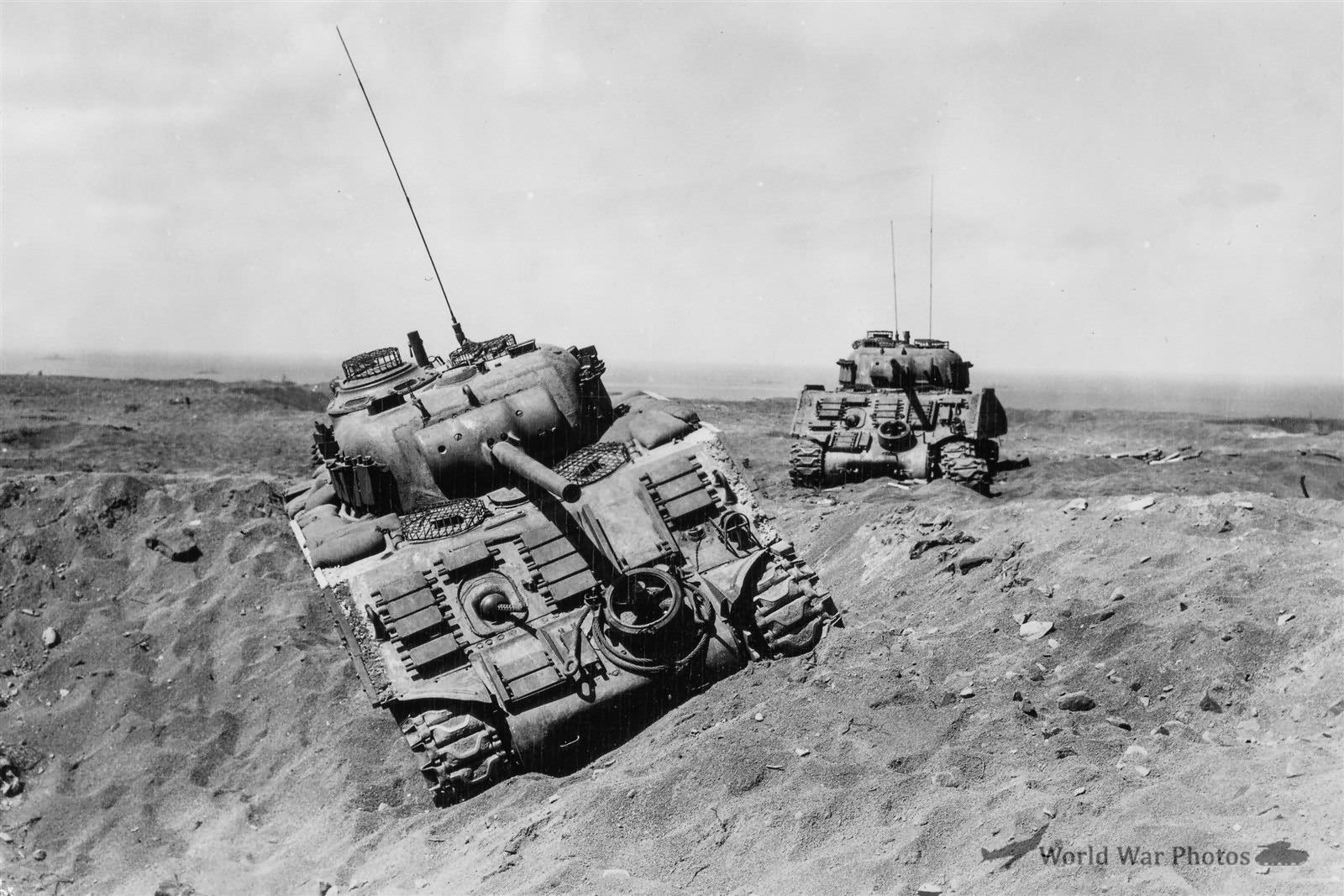The Battle of Iwo Jima was one of the most grueling and infamous campaigns of the Pacific War, comparable in its brutality to Tarawa and Peleliu. The island, a volcanic and sulfuric landscape with natural caves and fortified Japanese defenses, became the scene of an extended and bloody battle between U.S. Marines and well-entrenched Japanese forces. The campaign, which began on February 19, 1945, saw significant developments in the use of Marine tanks, with both sides adapting their tactics in response to previous experiences.
Japanese Defensive Tactics
By the time of the Iwo Jima invasion, the Japanese military had evolved their defensive strategy. Like at Peleliu, they shifted away from focusing on immediate defense of the beachhead, opting instead for a prolonged battle of attrition deeper within the island. Japanese tactics placed increasing importance on countering U.S. tanks, particularly through the deployment of Type 3 antitank mines. These mines, made with ceramic casings to evade magnetic mine detectors, were widely used on Iwo Jima.
Japanese defenses were heavily based around underground tunnels, reinforced bunkers, and the placement of improvised explosive devices (IEDs), including aircraft bombs and torpedo warheads along key routes. The 26th Tank Regiment, equipped primarily with Type 97-kai Shinhoto Chi-ha tanks, was forced to use these vehicles as static pillboxes, due to a shortage of replacements after many of their original tanks were lost at sea.
Marine Tank Deployment and Tactics
Iwo Jima saw the largest use of Marine tanks in the Pacific campaign, with three full tank battalions landed at the start of the campaign. These tanks played a crucial role in providing sustained fire support for infantry assaults and in attacking Japanese bunkers. The standard tank-infantry tactics developed during previous campaigns, referred to as “corkscrew and blowtorch” tactics, involved suppressing Japanese fortifications with tank fire, using satchel charges to weaken them, and finally clearing them out with flamethrowers.
The most effective flame weapons were the POA-CWS-H1 flame tanks, which far outperformed the auxiliary E4-5 flamethrowers mounted on regular tanks. Flame tanks proved indispensable in burning out entrenched positions, and their importance was evident in the sheer volume of fuel expended—one battalion alone used 5,200 gallons of fuel in a single day. In addition to flamethrower tanks, dozer tanks were invaluable for clearing paths and attacking bunkers by sealing their openings.
Terrain and Challenges
The volcanic soil of Iwo Jima, composed of soft pumice, posed significant operational challenges for U.S. tanks. Tanks often became bogged down or suffered broken tracks in the soft terrain, leading to high numbers of vehicles temporarily disabled. Mines were also a major problem, with Japanese forces using them extensively, augmented by the terrain conditions. Even smaller mines could cause severe damage, often snapping tank tracks. Repairing tanks under fire was dangerous, with many crew members being killed or wounded by small arms, mortars, or artillery while outside their vehicles.
Interestingly, more crew members were injured by indirect fire while outside their tanks than by direct fire while inside, highlighting the perils of maintaining tanks in the open terrain of Iwo Jima.
Key Operations and Casualties
The 5th Tank Battalion was assigned to the initial assault on Mount Suribachi, while the 4th Tank Battalion focused on seizing the airfields. Attempts to capture Airfield #2 early in the campaign were frustrated by the heavy use of mines and antitank guns, and the objective was only secured after several days of intense fighting.
Casualties among Marine tanks were high. By D+3, both the 4th and 5th Tank Battalions had lost about one-quarter of their tanks, and by the end of the first week, many companies were operating at half strength. For example, Company C, 5th Tank Battalion, started with 14 tanks but required 120 repairs, 29 of which were due to mines. The harsh conditions forced the Marines to improvise tank tactics, sometimes disregarding conventional methods due to the rugged terrain. Despite the large number of tanks temporarily out of action, recovery efforts managed to repair most of them, although a significant number were ultimately written off.
In total, the 3rd Tank Battalion lost 15 of its 49 tanks as total losses, while many others were out of action for periods due to battle damage. Tank crews suffered heavy casualties, though not as severe as the Marine infantry. The 4th Tank Battalion alone reported 122 casualties, including 24 killed, making up roughly 20% of its personnel.
Impact on the Battle
Despite the high losses, Marine tanks were deemed the “most effective supporting weapon” in the battle by U.S. commanders, as noted in the 9th Marine after-action report. The tanks’ ability to clear Japanese defenses and provide sustained fire support made them crucial to the eventual capture of Iwo Jima. The Japanese, likewise, recognized the importance of defeating U.S. tanks in combat, as they represented a key element in American superiority on the battlefield.
Ultimately, the Battle of Iwo Jima demonstrated the increasing sophistication of both American and Japanese tactics regarding armor. For the Marines, it underscored the importance of tank-infantry cooperation and the need for specialized vehicles like flamethrower tanks and dozer tanks to deal with the unique challenges of the Pacific campaign.
